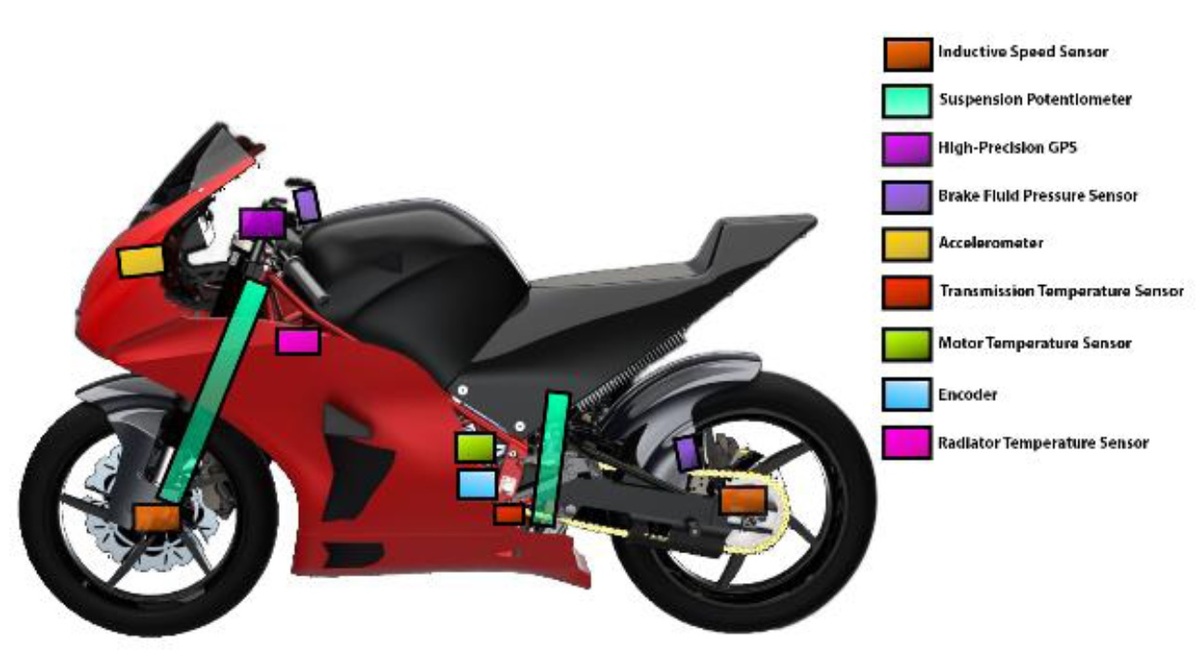Current issue
Online first
Archive
About the Journal
Aims and scope
Publisher and Editorial
Advertising policy
For Authors
Paper review procedures
Procedures protecting authentic authorship of papers
Paper preparation manual
Plagiarism check
Publication ethics
Reviewers
APC
Editorial and Scientific Board
Contact
Reviewers
The significance of telemetric data collection in electric motorcycles
1
Faculty of Mechanical Engineering, Wrocław University od Science and Technology, Poland
2
Faculty of Electronics, Photonics and Microsystems, Wrocław University of Science and Technology, Poland
3
Faculty of Information and Communication Technology, Wrocław University of Science and Technology, Poland
Submission date: 2024-12-30
Final revision date: 2025-04-14
Acceptance date: 2025-04-23
Online publication date: 2025-06-13
Publication date: 2025-08-28
Corresponding author
Monika Magdziak-Tokłowicz
Faculty of Mechanical Engineering, Wrocław University of Science and Technology, Wybrzeże Wyspiańskiego 27, 50-370, WROCŁAW, Poland
Faculty of Mechanical Engineering, Wrocław University of Science and Technology, Wybrzeże Wyspiańskiego 27, 50-370, WROCŁAW, Poland
Combustion Engines 2025,202(3), 67-73
KEYWORDS
TOPICS
ABSTRACT
Motorsport is a branch of the automotive industry that requires constant research and testing to gain
a competitive edge. A small change in a vehicle's suspension settings or engine management can make the difference between winning and losing in a particular competition. In order to ensure success, the vehicle is often pushed to its limits, however, while maintaining driver’s safety, all with the option of using vehicle telemetry, which collects, transmits and analyses vehicle data during and after driving. Operational parameters measured in real time are analyzed for future corrections and improvements. This paper presents an analysis of telemetry testing, of an electric motorbike, related to energy consumption, power output, torque and thermal conditions to improve the efficiency of the drivetrain on the Aragón circuit in Spain at the MotoStudent competition. The article also demonstrates how to validate the values of individual parameters obtained during calculations and simulations, as well as the impact of minor changes on these parameters. It also describes how telemetry helps in assessing the skills of drivers.
REFERENCES (21)
1.
Bartolozzi M, Boubezoul A, Bouaziz S, Savino G, Espie S. Data-driven methodology for the investigation of riding dynamics: A motorcycle case study. IEEE Trans Intell Transp Syst. 2023;24:10224-10237. https://doi.org/10.1109/TITS.2....
2.
Bonini F, Rivola A, Martini A. Braking torque estimation through machine learning algorithms. Materials Research Proceedings. 2023;26:213-218. https://doi.org/10.21741/97816....
3.
Calderón AG, Galbeño Ruiz G, Carlos A, Bohórquez G. GPRS telemetry system for high-efficiency electric competition vehicles. 2013 World Electric Vehicle Symposium and Exhibition (EVS27). Barcelona 2013. https://doi.org/10.1109/EVS.20....
4.
De Carlo M, Simeone E, Radano L, Carello M. A telemetry-driven architecture for the development of data-intensive race strategies. 2024 International Conference on Artificial Intelligence, Computer, Data Sciences and Applications (ACDSA), Victoria 2024. https://doi.org/10.1109/ACDSA5....
5.
Cossalter V, Bellati A, Doria A, Peretto M. Analysis of racing motorcycle performance with additional considerations for the Mozzi axis. Veh Syst Dyn. 2008;46:815-826. https://doi.org/10.1080/004231....
6.
Cossalter V, Doria A, Formentini M, Peretto M. Experimental and numerical analysis of the influence of tyres properties on the straight running stability of a sport-touring motorcycle. Veh Syst Dyn. 2012;50:357-375. https://doi.org/10.1080/004231....
7.
Cossalter V, Doria A, Garbin S, Lot R. Frequency-domain method for evaluating the ride comfort of a motorcycle. Veh Syst Dyn. 2006;44:339-355. https://doi.org/10.1080/004231....
8.
Fouka M, Nehaoua L, Arioui H. Motorcycle state estimation and tire cornering stiffness identification applied to road safety: Using observer-based identifiers. IEEE Trans Intell Transp Syst. 2022;23:7017-7027. https://doi.org/10.1109/TITS.2....
9.
Fujii S, Shiozawa S, Shinagawa A, Kishi T. Steering characteristics of motorcycles. Veh Syst Dyn. 2012;50(8):1277-1295. https://doi.org/10.1080/004231....
10.
Katayama T, Aoki A, Nishimi T. Control behaviour of motorcycle riders. Veh Syst Dyn. 1988;17:211-229. https://doi.org/10.1080/004231....
11.
Leonelli L, Limebeer DJN. Optimal control of a road racing motorcycle on a three-dimensional closed track. Veh Syst Dyn. 2020;58:1285-1309. https://doi.org/10.1080/004231....
12.
Markowski M, Szczepan S, Zatoń M, Martin S, Michalik K. The importance of reaction time to the starting signal on race results in elite motorcycle speedway racing. PLoS One. 2023;18. https://doi.org/10.1371/journa....
13.
Moreno D, Mucchi E, Dalpiaz G, Rivola A, Mucchi E. Multibody analysis of the desmodromic valve train of the Ducati MotoGP engine. Multibody Dynamics 2007, ECCOMAS Thematic Conference. Milano 2007.
14.
Ruzicka J. 2020 Smart Cities Symposium Prague (SCSP): Prague, June 25th, 2020. IEEE.
15.
Sharp RS, Evangelou S, Limebeer DJN. Advances in the modelling of motorcycle dynamics. Kluwer Academic Publishers 2004.
16.
Stincescu T, Zhao R, Ballantyne EEF, Stone DA, Foster MP. MATLAB-based high-performance electric motorbike energy model, utilising video data. 16th International Conference on Ecological Vehicles and Renewable Energies, EVER 2021. Monte-Carlo 2021. https://doi.org/10.1109/EVER52....
17.
Tobiáš M, Porteš P, Zháňal L, Fojtášek J. Measurement and analysis of dynamic riding behavior of a motorcycle. Engineering Mechanics 2020. Institute of Thermomechanics of the Czech Academy of Sciences, Prague; 2020:488-491.
18.
Venceslau de Souto JI, Barbosa da Rocha Á, Duarte RNC, de Moura Fernandes E. Design and implementation of an embedded data acquisition system for vehicle vertical dynamics analysis. Sensors. 2023;23. https://doi.org/10.3390/s23239....
19.
Villa-Salazar AF, Gomez-Miranda IN, Romero-Maya AF, Velásquez-Gómez JD, Lemmel-Vélez K. Optimizing electric racing car performance through telemetry-integrated battery charging: A response surface analysis approach. World Electr Veh J. 2024;15(7):317. https://doi.org/10.3390/wevj15....
20.
Zhang XD, Chen CK. A study of a cornering braking control system for a motorcycle. Appl Sci. 2022;12(24|):12575. https://doi.org/10.3390/app122....
21.
Zhu D, Pritchard E, Dadam SR, Kumar V, Xu Y. Optimization of rule-based energy management strategies for hybrid vehicles using dynamic programming. Combustion Engines. 2021;184(1):3-10. https://doi.org/10.19206/CE-13....
We process personal data collected when visiting the website. The function of obtaining information about users and their behavior is carried out by voluntarily entered information in forms and saving cookies in end devices. Data, including cookies, are used to provide services, improve the user experience and to analyze the traffic in accordance with the Privacy policy. Data are also collected and processed by Google Analytics tool (more).
You can change cookies settings in your browser. Restricted use of cookies in the browser configuration may affect some functionalities of the website.
You can change cookies settings in your browser. Restricted use of cookies in the browser configuration may affect some functionalities of the website.



